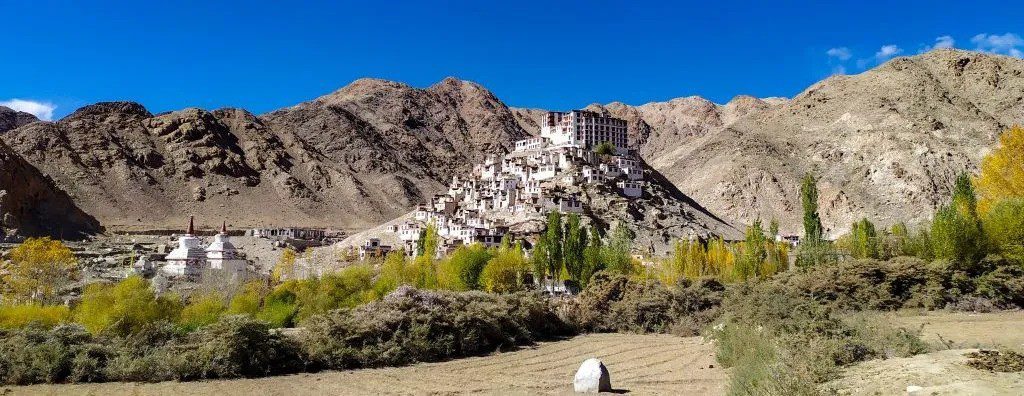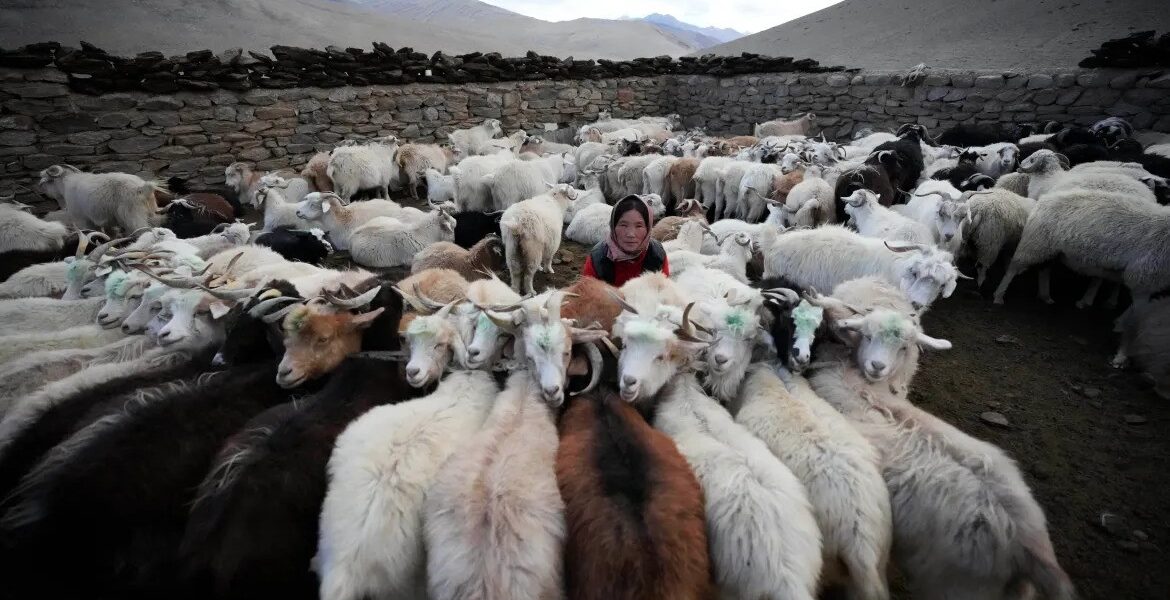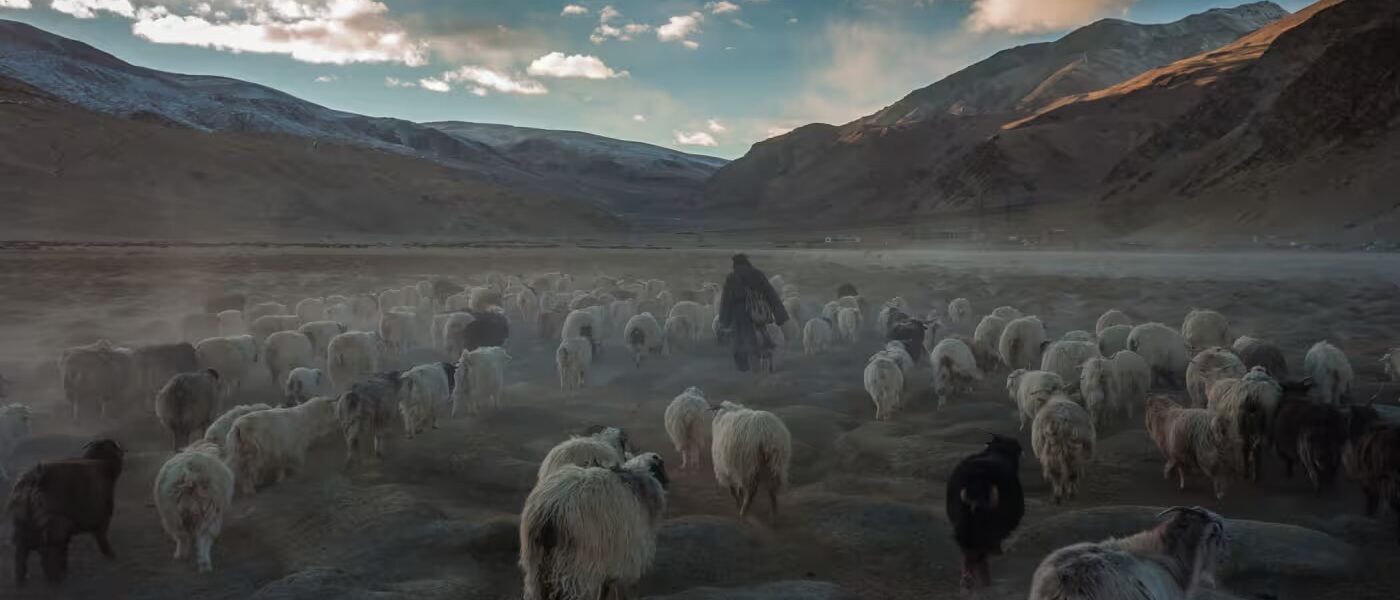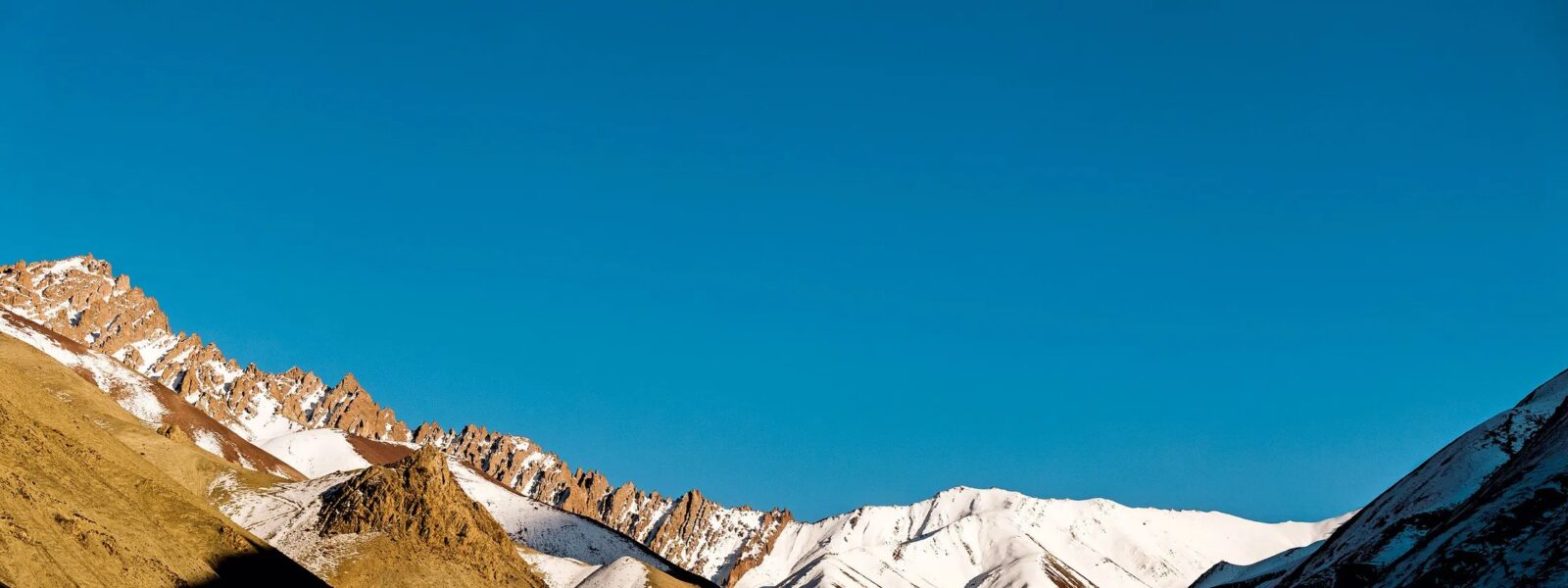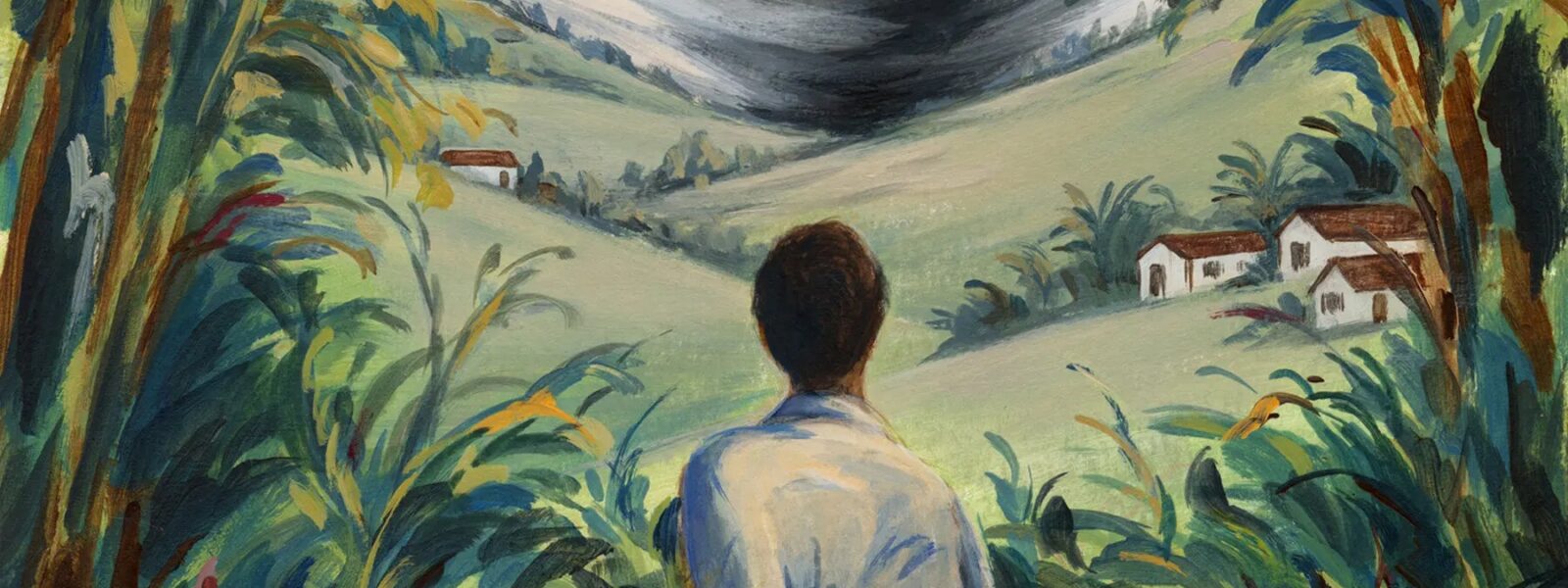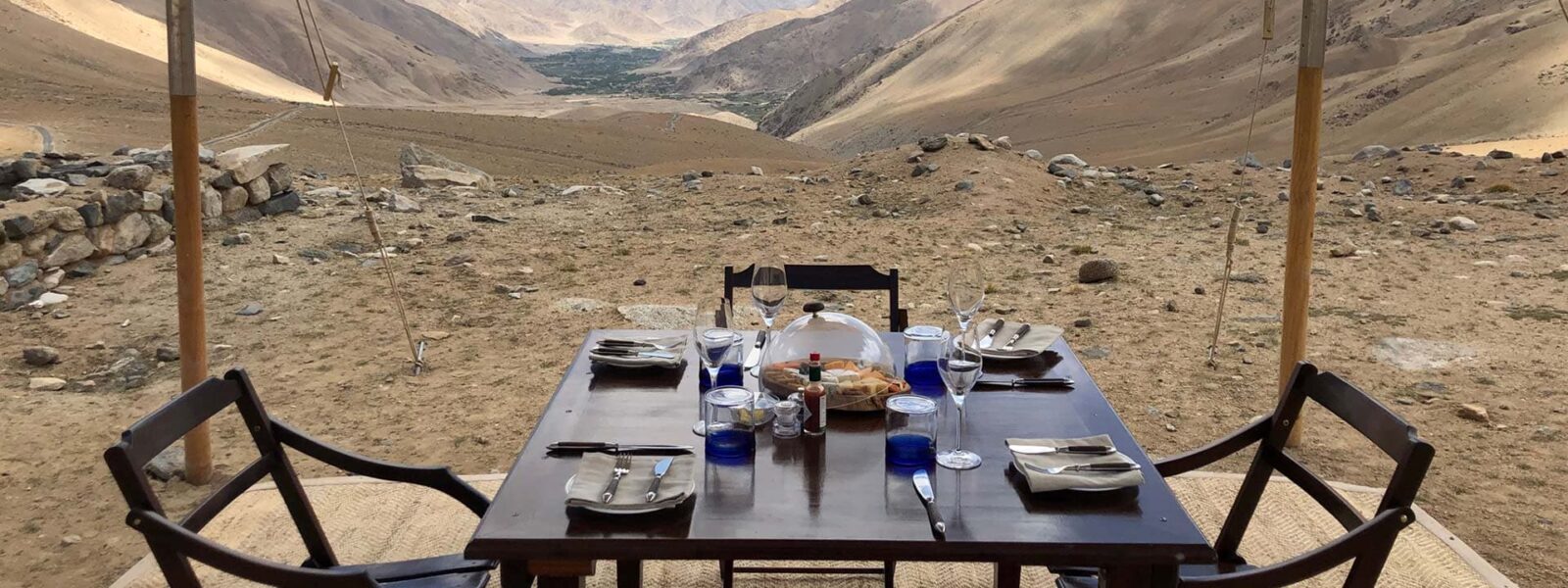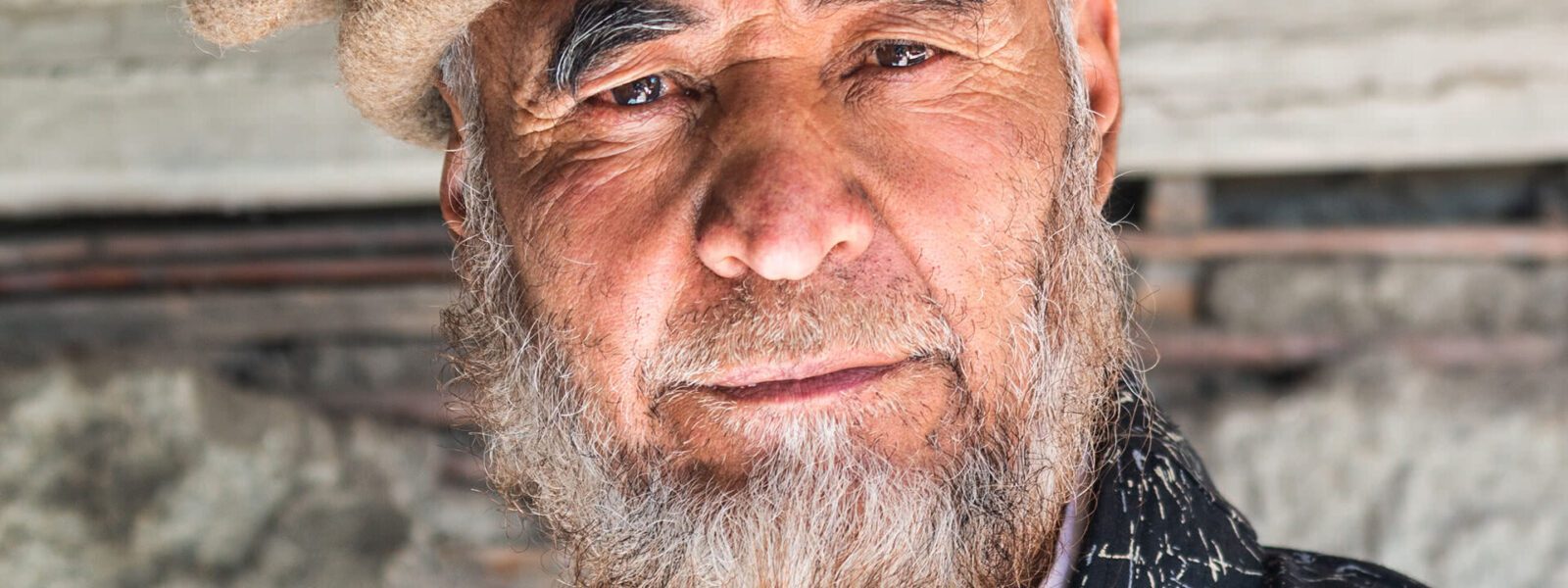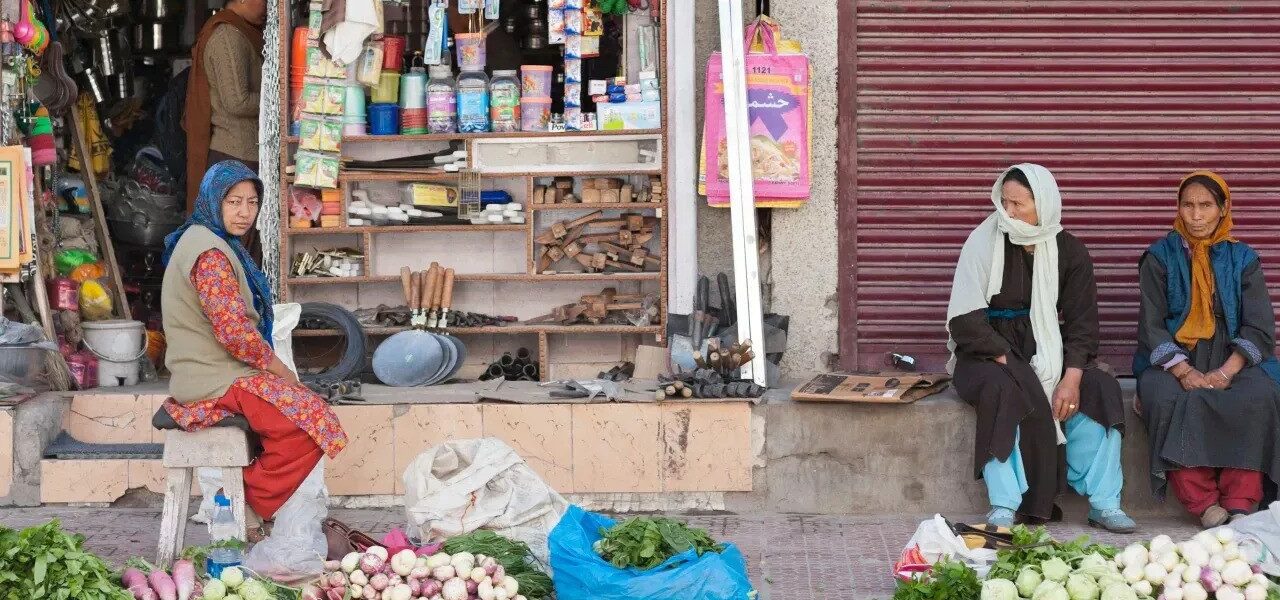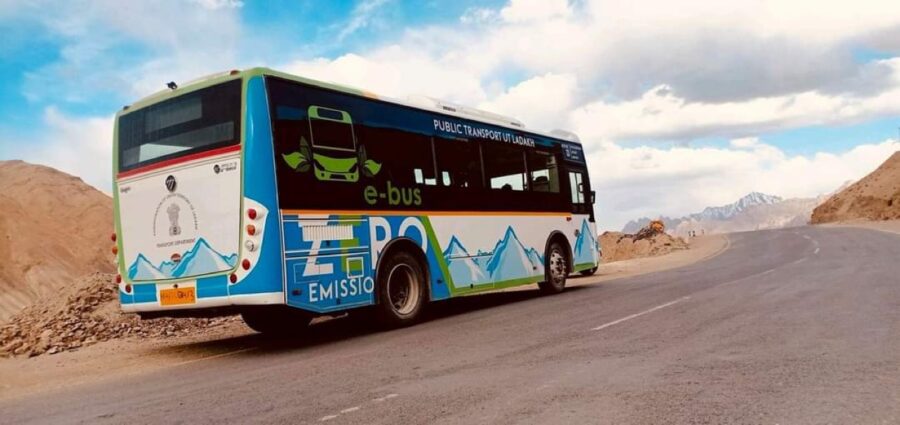LADAKH: THE MONASTERY TRAIL
After Leh, we venture onto the monastery trail. Thikse, Chemdey, Hemis, and Lamayuru: four Buddhist sanctuaries in Ladakh, the ones we dreamt of as children, now suddenly within reach. These unforgettable moments will be our last in India, marking the close of our nine-week journey in this vast country.
Leh is beautiful, but it’s just a glimpse of Ladakh. After two days in the town, our eyes instinctively drift toward the horizon, the mountains calling us to continue the adventure deeper into the solitude they offer. We’ve mapped out four monasteries that fascinate us. The closest is just 15 kilometers away, a trip that could, in theory, be done in half a day. The farthest, however, lies 110 kilometers from us, requiring at least one night’s stay—if we can find lodging still open at the end of October.

Traveling Ladakh by Bus? Yes, It’s Possible!
“Are there buses to Hemis?” Our host seemed perplexed by the question. “Travelers usually rent a motorbike or hire a driver for the day,” he replies patiently. We don’t know how to ride a motorcycle, and hiring a car with a driver doesn’t fit our long-term travel habits or budget. So, are there buses to Hemis? “Hmm… There’s a bus to Choglamsar… And from Choglamsar, you can catch another to Karu… Karu is 6 kilometers from Hemis… It’s walkable, though it’s a steep climb and takes time. But sometimes, you might find a taxi.”
We cling to what we needed to hear: yes, traveling by bus in Ladakh is doable, even as winter approaches. It’s more challenging than elsewhere in India due to the sparse population and, consequently, fewer buses, but it’s feasible. And there’s even a silver lining: fewer chances to get lost. Only three major roads lead out of Leh—one heads north toward China, another west to Kashmir, and the last winds through a high pass to the rest of India. If you board the wrong bus, you’ll realize it soon enough.
Cautious but excited, we decide to take things one step at a time. Tomorrow afternoon, we’ll visit the closest monastery, Thikse. If that goes well, the next day will take us to Hemis and Chemdey, 40 kilometers from Leh. And finally, the day after, the most remote of them all: Lamayuru. Adventure awaits!

A Full Vehicle
As is often the case in India, the concept of “full” is stretched to its limits. Local buses don’t adhere to strict schedules; they leave when they’re full, which doesn’t just mean all the seats are taken. The central aisle, footstep outside, and occasionally even the roof all count as usable space. While waiting for the bus to fill, we buy two bananas from a street vendor—a small luxury since arriving at 3,500 meters above sea level.
It takes us an hour and a half to cover the 15 kilometers. The driver drops us off casually at a crossroads where the main road meets the smaller route leading to Thikse. We’ve got two kilometers left to walk, but it’s no trouble—it’s only 2 PM, and the sun is still high in the sky. As we pass through a large stone and wooden gate that marks the entrance to this sanctuary, the monastery suddenly comes into view, hidden from us while on the bus.

Our First “True” Monastery
A colossal white fortress of stone straddles the mountain. Below, a line of stupas and dozens of small, white cottages – the homes of the monks – spread out at its base. The path we follow winds between them. As we trudge upward, a lone figure descends in the opposite direction: a monk dressed in a saffron robe and a yellow hat, the color of the Thikse order. He greets us with a wave and a smile. The renowned Ladakhi hospitality remains ever-present.
There is no other visitor around, no one else except that monk, now a distant figure. Just a dog, who seems to have decided to climb with us. This has become a familiar scenario – Matthieu enjoys speaking to every stray dog we meet, though Pierre tries to dissuade him each time. Ten minutes later, the three of us – Pierre, Matthieu, and the dog – reach the top.
A small guard post marks the entrance for tourists. During high season, visitors are charged a fee. But in the low season, like today, the entry is free. We take a few more solemn steps and finally enter our first “true” Buddhist monastery. This is a significant moment, one we’ve been anticipating since arriving in Ladakh, perhaps even since setting foot in India. The stuff of childhood imagination, inspired by books and films – from Tintin to Seven Years in Tibet, and the exhilarating accounts of Alexandra David-Néel – is now unfolding before our eyes. We had dreamt of this. And now, we are living it.

A Place Beyond Us
Thikse embodies everything you could hope to find in a Ladakhi monastery: a sanctuary of profound peace and devotion, a place steeped in history and heritage with ancient artifacts you can almost touch with your eyes, and a space for contemplation with terraces that offer some of the most breathtaking views of the Indus Valley. It’s also a living space where monks chat casually, check their smartphones, laugh, and carry a sincerity in their actions without taking themselves too seriously.
It’s hard to put into words exactly what we felt at that moment. Our eagerness and curiosity faded into deep respect for what has been lived here and what still endures. We felt small, insignificant, intruding upon something far greater than ourselves – vast, immense, and almost sacred. The word “sanctuary” took on a profound meaning. This place transcended us.
The next day, we felt the same awe as we entered Hemis. After two hours on a bus and a hard-negotiated taxi ride, we arrived at this remote corner of the world nestled carefully among the mountains.

Hidden from Profane Eyes
Unlike Thikse, you don’t see Hemis until you’ve arrived. Right until the last moment, you think it can’t possibly be there, hidden as it is by the towering peaks around it. And then, suddenly, it’s right in front of you, standing tall and proud. This concealment has allowed it to escape the invasions that ravaged other monasteries in Ladakh throughout the centuries. Here, everything has withstood time and man: the wooden beams, the paintings, the gilded decorations, and the ancient manuscripts.
Seventy monks continue to safeguard this spiritual treasure, training the next generation – some thirty children who, as we arrived, were studying and praying with a solemn dedication in the courtyard. We also witnessed the creation of a mandala, those fragile sand drawings that take days to make, only to be swept away by a single gust of wind.

On the Banks of the Indus
Just across the valley lies Chemdey, 20 kilometers away as the crow flies. We descend on foot to Karu, soaking in the autumn colors, pausing at the banks of the Indus River. This river, ever-present yet distant since our arrival in Ladakh, holds a sacred place in the hearts of Hindus. From Varanasi to Madurai, everyone spoke of it with a deep, almost filial attachment, often with a love that seems impossible for a river. Love for a river – yes, that’s what it is. We couldn’t leave India without touching, even briefly, this central piece of the puzzle we’ve been piecing together for nine weeks.

Crossing the Indus, our legs remind us that we are at 3,500 meters. Descending is fine, but there’s no way they’ll carry us the 10 remaining kilometers to Chemdey. So, we decide to hitchhike. Perhaps it’s because we’re not used to it, or maybe it’s just the deserted road, but it takes us nearly an hour to convince a passing car to stop.
Hitchhiking Isn’t Indian
“You’re lucky I’m taking this route. I’m heading to a lake on the border with China. Do you know it? It’s beautiful. You should visit it when you have time,” our driver tells us in excellent English. We listen politely as he extols the beauty of Ladakh, but our eyes are glued to the landscape. Thikse and Hemis had already won us over, but the sight of Chemdey emerging from the horizon feels almost mystical.
The hill it sits upon seems like it exists solely for the monastery. It’s hard to imagine a time when it was barren, without this white iceberg of purity standing proudly at its center. The fact that humans built this is astonishing. We are mesmerized.
“We’re here,” our driver interrupts, parking without us even noticing. We thank him warmly as we hop out of the car. “Fifty rupees will do,” he says, as we pay. Hitchhiking isn’t a part of Indian culture. If we had to pay, we would’ve preferred being dropped off closer. We still have a few kilometers to cover on foot before reaching the monastery.
Face to Face with Yaks
Around Chemdey, the same silence, the same tranquility that has defined our days in rural Ladakh greets us. Even the wind seems to pause, unwilling to disturb the peace of the monastery. As we cross the fields, we come face to face with our first yaks – thick, woolly cows built to withstand the harshest cold.

Their owners laugh as we pass by, surprised to see us walking here. They don’t miss their opportunity to be polite, greeting us with multiple “Julley”s, to which we enthusiastically respond with our own “Julley.” The word is repeated so often it becomes a conversation in itself.
Once again, breathless and with aching legs, we reach the monastery’s courtyard. As we carefully explore each room, the fatigue sets in. But the monks’ hospitality quickly brings comfort in the form of hot, sweet tea, which we sip as we sit near them.
This hospitality stays with us until the very end, as it’s a monk from the same monastery who picks us up on the way back and drops us off at the bus stop just as we were beginning to dread the thought of walking all the way down.

One of the World’s Most Beautiful Roads
Day trips done, but with just a few brief glimpses, it’s hard to truly absorb the life of Ladakh, its villages, and its monasteries. So we extend our journey westward to Lamayuru, at the far edge of the region, on the doorstep of Kashmir’s sensitive zone. A bus leaves Leh every noon and reaches Lamayuru by dusk. It returns the next day at midday. As one morning isn’t enough to fully experience Lamayuru, we plan to stay two nights.
Six hours on the road, though more like six hours of a visual feast. Far from being long or monotonous, this bus ride is perhaps the most beautiful we’ve ever taken. After passing military bases that blend into the scenery, we reach vast, desolate plateaus, eerily silent except for the hum of the engine.
Then, we wind through narrow gorges where the Indus and its tributaries flow. The mountains of Ladakh are all shades of gray, rising and falling along roads that twist and turn along cliffs. Suddenly, the vivid blue of water born from eternal glaciers flashes before our eyes.
Crossing the Passes
We’re tossed side to side in our seats as the driver, far too accustomed to this route, speeds along the serpentine roads. We feel the altitude as we ascend the passes, our breath catching even though we’re sitting still.

A cloud drifts by, changing the colors around us in an instant. Or perhaps it’s the rocks, abruptly shifting the scene to shades of ochre or red, as if someone had painted the cliffs. We gasp in surprise and joy, becoming children again.
Parking in Small Towns
In the small towns we pass through, our bus is the event of the day. It’s the only thread connecting these remote villages to the rest of the world. The vehicle brings home a family member who left months ago for work in the city, delivers a long-awaited package, or carries a spare part they’d given up hope on. It brings news from “out there,” from Leh, from elsewhere, exchanged in hurried words with the driver.
No Problem, No Problem
Once the villages are behind us, as we settle into the final stretch of road and anticipate our arrival, an unexpected stop occurs. In the middle of nowhere, a red-and-white barrier blocks the road. The driver cuts the engine and turns, not to the dozen other passengers, but just to us.

“Police… Passport,” he mumbles, gesturing for us to get off. At the foot of the bus, a soldier greets us with two more words: “Control. No problem. Control. No problem.” As he repeats “no problem” over and over, we start to wonder if there actually is a problem.
Inside a small house, an officer who speaks slightly better English asks where we are heading. “Lamayuru? No problem. And then back to Leh? No problem,” he assures us. The checkpoint is meant to register foreign travelers heading toward Kashmir. For us, it’s just a matter of jotting down our details in a ledger and promising to return in two days. We climb back onto the bus, and as promised, by nightfall, we arrive.
Room With a View
We’re dropped in the heart of the village. Looking up, we spot our hotel: it’s perched two hundred meters higher, nestled against the monastery. We make our way up a rocky path, flashlights illuminating the way.

After a few fruitless phone calls, we finally found the Niranjana hostel. It’s nothing special. It’s open, and that’s about it. Downstairs, a large wooden room serves as the dining hall. It’s set for a hundred, but there are only five guests. The food is uninspiring – even the pasta is poorly cooked. Upstairs, long hallways lead to clean rooms with no heating, and the shared bathrooms are quite run-down. Hot water is hit or miss, and we’ll stay cold throughout our stay.
But despite all this, there’s magic. From our window, we see young monks playing football in the courtyard of the monastery. From the balcony, we watch the lights flicker in the village below. We can’t see the stars. At night, clouds shroud Lamayuru, while the mountains form a protective barrier around us. The temperature slowly drops below zero, and a biting wind hits our faces. We retreat quickly under the covers.
The Path to the Gompa
At dawn, we wander through the narrow streets. We encounter only three elderly women, warmly wrapped in woolen tunics. “Julley,” they shout cheerfully at us. With their household chores done, they climb to the monastery to pray and spin the prayer wheels, hoping to earn Buddha’s blessings.

Near the bus stop, a small canteen has opened. We quickly befriend the owner and have all our meals there, avoiding the disastrous cook at the hotel. We walk to the edge of Lamayuru, past fields devoured by the cold. A few shaggy yaks search for the last bits of grass.
We want to reach the monastery from the other side of the mountain. “Gompa?” we ask a woman, pointing to a steep path. “Gompa,” she confirms, pointing in the same direction. The climb takes us to a promontory with views of both the valley and the monastery.
We stumble upon the old, now abandoned village of Lamayuru, a collection of ruins that still holds a small chapel. It’s locked, but we ask the monks for the key. As we remove the large metal padlock, we wonder what treasures lie inside. Inside, we find statues of Buddha and terrifying demons armed with swords.
Final Images of India
Finally, we visit the monastery itself. The young monks are singing and playing instruments in the main hall. We stand at the doorway, not wanting to interrupt. One of them approaches us, offering biscuits, happy to share this moment – so ordinary for them, so extraordinary for us – with two strangers. They then head outside to eat together in the fresh air. We leave them in peace and make our way to the highest stupa, from where we can see everything.

We don’t realize it at the time, but these unforgettable images will be among the last of our journey in India. Sixty-eight days, and a chapter is closing. In twenty-four hours, we will leave Ladakh, then the continent, bound for the second destination of our world tour: Indonesia.
It won’t be until we’re lounging on a pristine beach that we’ll suddenly realize: we’ve fallen in love with India.
The Reference Article LADAKH : LA ROUTE DES MONASTÈRES

